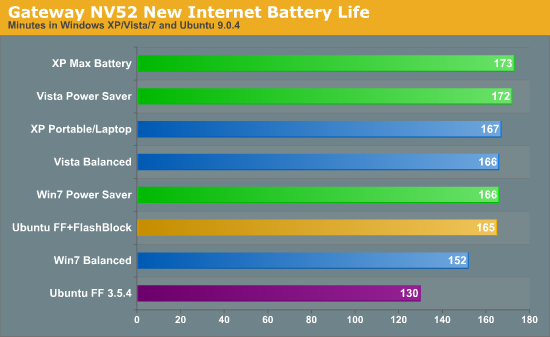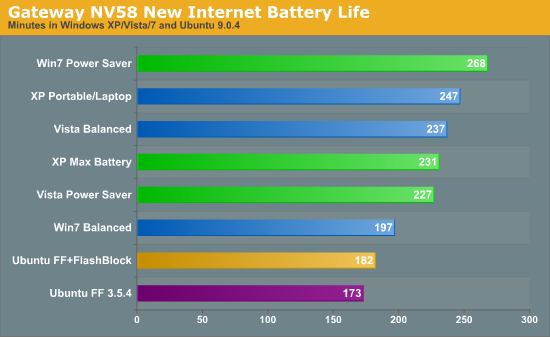Internet Battery Life, Round 2
We were a bit concerned with some of the Internet battery life results, so we decided to retest all of the systems using different websites. We felt that variance in the content of the webpages we used originally, even with repeated testing, might have skewed some of the results, so we switched to websites that present content more consistently. This time, we selected Yahoo!, MSN, the main YouTube page (no videos actually playing), and the Facebook login page (representing a simple web page, though logging in on Facebook makes it a lot more complex). The Yahoo! page is active while the other three are in tabs and their content is not visible. Here are the results for both systems.
[Drum roll…]


Okay, we're not finished yet, since we're still running some of these tests on the laptops. We'll update this page as we complete additional tests, so check back during the week. You can see what we mean when we say the results were inconsistent, however, as the placement of certain OSes is very different from our original Internet tests. On the NV52, all of the Balanced battery results are a lot closer to the Power Saver results this time, with the largest difference coming in Windows 7 at 9%. That isn't entirely out of sync with what we would expect, since Flash content may result in the CPU running at higher speeds without the limits imposed by Power Saver. However, Windows 7 suddenly drops to the back of the pack and we again have to question the results. [Queue yet another retest.] Ubuntu still shows a 27% boost in battery life by using FlashBlock, but that's less than the 44% boost shown originally. That makes sense, considering we aren't using sites with nearly as much Flash content. We will update the charts with Vista + Firefox results later this week and rerun the Windows 7 tests just to be safe.
The NV58 results aren't any better at clearing things up, since this time Windows 7 has a huge lead in its Power Saver result but trails by a significant amount in the Balanced test. So despite using sites that appear to be more consistent at first blush, we're afraid that there's still variability and we need to run more tests. Another interesting aspect is that Ubuntu hardly shows any difference between Firefox and Firefox + FlashBlock on the NV52, garnering a scant 5% increase in battery life. At least XP and Vista generate relatively consistent results, which is more in line with what we would expect. Of course, expectations are frequently wrong, which brings us to round three….










106 Comments
View All Comments
JarredWalton - Tuesday, September 22, 2009 - link
I don't think it works quite like that. If you set it to 0%, I believe that's the minimum CPU speed (i.e. 5.25 x 200MHz on the NV52 and 6 x 200MHz on the NV58), while the higher percentage may try to target a maximum speed. 100% would be the normal CPU speed, but would 50% be half-way between minimum and maximum?I'd have to investigate more, but I do remember testing with CPU-Z and seeing CPU clocks go well above the 50% mark. I think at best it's approximate, as you suggest, and how accurate it is likely varies greatly with the CPU - and even BIOS options.
trochevs - Tuesday, September 22, 2009 - link
Looking the starting times (startup and resume) I have the feeling that Ubuntu has some kind of problem on your hardware. I have quite bit experience with Dell and Lenovo and Ubuntu 9.04 is always faster to boot compare to any Windows. It is not only my experience, but I am doing test on one senior citizen and one teenager. They both agree with my observation. You should press Alt-F1 during the boot and check for any errors. Gateways could have some additional peace of hardware that does not work correctly under Ubuntu and the kernel has to wait to time-out.In regards out of the box experience you should get hold of the system that is optimized for Linux (Ubuntu) just like the Gateway is optimized for Windows. www.system76.com or Dell http://www.dell.com/content/topics/segtopic.aspx/u...">http://www.dell.com/content/topics/segt...s=19&... would be good start. Then you don't have to fool with drivers. I would love to see how much optimization has been done by System76 and Dell.
ekul - Tuesday, September 22, 2009 - link
It's true; ubuntu 9.04 boots very quickly and 9.10 will be even better. On my netbook and my desktop 9.04 boots in a lot less then 30 seconds. I agree something isn't quite right with the boot procedure.The other thing to keep in mind for linux boot times is once the desktop is displayed the system is fully up. No background loading, no delayed startups. On Vista and 7 I find after the desktop appears it will take another 30-45 seconds before the HD is done reading and the system is responsive
oyabun - Tuesday, September 22, 2009 - link
Thank you very much for an enlightening article. I am one of the people who indeed care for battery life!Regarding your testing methodology where you drain each battery over and over again, wouldn't it be more efficient to take the battery out of the equation (and physically remove it) completely? Just measure the Wh consumed by the power brick during 30 or 60 minute runs and extrapolate to the capacity of the battery. That would greatly reduce your testing times.
You should of course measure at the DC end of the transformer, otherwise you should factor in it's efficiency.
You could even calibrate the whole procedure with a single battery powered run. It certainly beats what you are currently subjecting yourself to! :-)
Keep up the good work!
JarredWalton - Tuesday, September 22, 2009 - link
My experience is that laptops typically switch to different power states on AC vs. DC power, even if you have all the settings the same. It's possible to estimate battery life, but I do like to do "real world" testing where possible. Anyway, it's not a bad idea and I may do a follow up article at some point looking at just the power numbers. Taking the power transformer efficiency out of the equation isn't something I'm equipped to do right now, unfortunately. I can measure power at the outlet... and that's it. And it's only accurate to ~1W there so I'd need a better device than my current Kill-A-Watt.BTW, have you ever stared at a small Kill-A-Watt display while running tests? Frankly, running battery tests where I can walk away and collect the results later is less painful all around! :)
oyabun - Wednesday, September 23, 2009 - link
Of course a Kill-A-Watt won't cut it! You need a datalogger on a separate PC and a power gauge, logging the total energy consumption over any period of time unattended. With such a setup you would be able to measure from the DC side by splicing the wires leading from the transformer to the notebook. And, naturally, a datalogger support more than one gauge, so you could measure in parallel.I understand what you mean when you say that power profiles behave differently under AC. It is possible though your (and mine) experience is based on Windows XP. Perhaps Windows 7 are more consistent.
oyabun - Wednesday, September 23, 2009 - link
I didn't see the comments by Kibbles before. Our posts convey the smae message!And I concur, the power supply testing team appears to have the tools for the job.
strikeback03 - Wednesday, September 23, 2009 - link
Yeah, IIRC they're also in Europe, while Jarred is in Seattle or somewhere out west.JarredWalton - Wednesday, September 23, 2009 - link
There's more to it than that, but suffice it to say I don't have power testing equipment and it's not high on my list of priorities right now. Rough estimates are sufficient on the power side of the equation, since you get whatever power brick the laptop comes with. It's not like you can upgrade to a more efficient power brick with a Dell laptop.Kibbles - Tuesday, September 22, 2009 - link
"maybe borrow it from the powersupply setting team"I meant "powersupply testing team".
Also for the convenience of being able to walk away. As long as you get a voltmeter with logging capability, you can leave it to do it's thing and just pull up the logs.